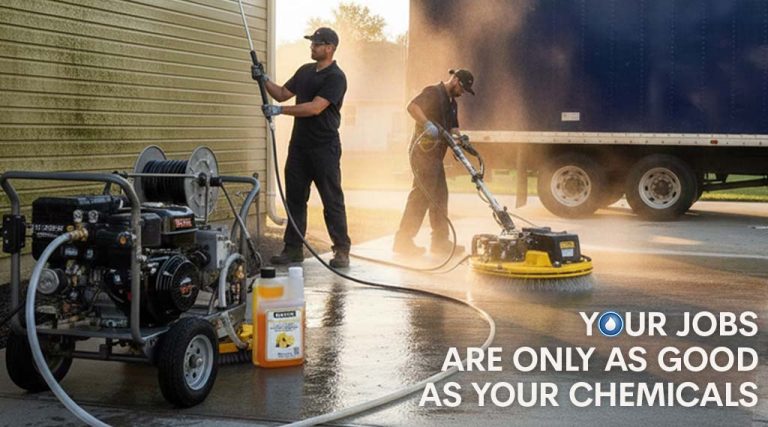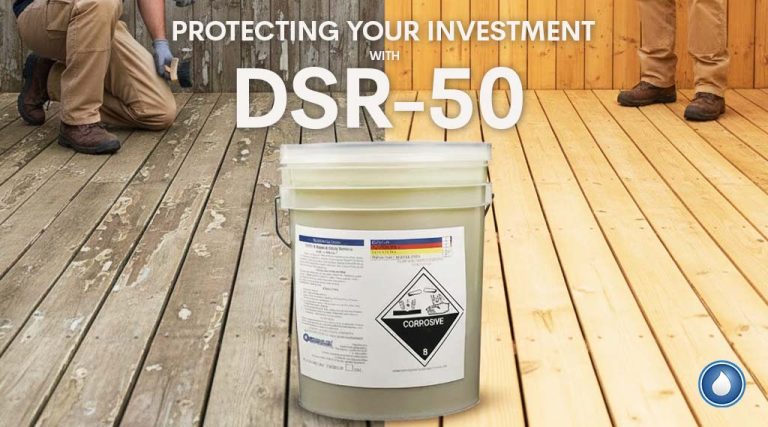- Home
- /
- Power Wash Spray Tips
- /
- Beginning to End Dumper Pad Cleaning: Part 1
Subscribe To Our Newsletter
Stay in the know on the latest products, deals, events, tips & tricks.
Social Media
Beginning to End Dumper Pad Cleaning: Part 1
Our cleaning crew was recently called in for a severe dumpster pad cleaning project after the dumpster emptying crew accidentally knocked over kitchen grease receptacles, spilling thick kitchen grease all over the pad.
To clarify, kitchen exhaust grease is created when fumes rise through the vents, then settle in the vents once they cool back down. It can become a fire hazard if not removed, which is why restaurants and other cooking facilities are required by law to have their exhausts cleaned. The grease is usually placed in barrels then picked up by waste collection services that recycle it for a variety of biofuel purposes. However, in this situation, the grease spilled all over the ground.
With regular maintenance, a dumpster pad can be cleaned in 15 to 30 minutes. This job was not typical. It was thick, slippery, and extremely nasty. It needed to be cleaned up quickly to help keep bugs, rodents, and germs away, as well as to prevent slips and falls.
The Cleaning Process
Kitchen grease is different than the type of grease you would normally find in a parking lot. Kitchen exhaust grease is an organic grease, whereas vehicle grease is usually synthetic. For this spill, we needed to use a degreaser designed for kitchen grease.
We carry two different kitchen exhaust degreasing products that are almost identical: Green Beast (a.k.a. V502) and Clearly Clean Xtreme. The only difference is that Green Beast has a color-marking dye, which lets you see where you’ve cleaned. Some people really like being able to see where they’ve sprayed it so they love Green Beast. Others are don’t want their customers to see the green, so they use Clearly Xtreme Clean. It’s just a personal preference and they both are great for removing non-trans fat oil build-up from kitchen exhaust hoods, and in our case, the dumpster pad.
Green Beast and Clean Xtreme are sold as a powder that you add to water. The usual mixture is 8 ounces per gallon. However, because the grease was so thick in this situation, we doubled that – 16 ounces per gallon, and mixed with two gallons of water.
Our preferred method for mixing is in a 5-gallon carboy, which is a chemical resistant container with a 3-inch opening/lid on top. Our team used a long pole and stirred the mixture for a couple of minutes. When using a strong mix like we did, it may be hard to get all the powder to dissolve. If this happens, you should go ahead an add a little more water and keep missing until the chemical is completely dissolved. The mix will feel warm to the touch because of the chemical reaction, and if you get some one you, you’ll feel it.
Share This Post
More To Explore
Winter Pressure Washing Maintenance Checklist
Winter Pressure Washing Maintenance Checklist Prepared for Contractors by PowerWash.com. Winter is the most important time of year to protect ...
2025 Tax Changes, New Rigs & Easy Payments: What Power Washing Pros Need to Know Before Dec 31
Updated for the latest federal guidelines. PowerWash.com does not provide tax advice. Always consult your CPA. As the year comes ...
Your Jobs Are Only as Good as Your Chemicals: Here Are the Ones That Stand Out
If your busy season has you running from job to job, you already know this: the equipment you use matters, ...
Stripping Wood the Smart Way (Not the Hard Way)
Deep Wood Restoration Made Simple with DSR-50 Whether you’re a professional deck and fence restoration contractor or a homeowner prepping ...




